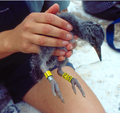| African oystercatcher | |
|---|---|
 | |
| African oystercatcher in Betty's Bay | |
| Scientific classification | |
| Domain: | Eukaryota |
| Kingdom: | Animalia |
| Phylum: | Chordata |
| Class: | Aves |
| Order: | Charadriiformes |
| Family: | Haematopodidae |
| Genus: | Haematopus |
| Species: | H. moquini |
| Binomial name | |
| Haematopus moquini Bonaparte, 1856 | |
 | |
| breeding range population range | |
| Synonyms | |
Metanibyx africana? Contents | |
The African oystercatcher or African black oystercatcher (Haematopus moquini) is a large charismatic wader resident to the mainland coasts and offshore islands of southern Africa. This oystercatcher has a population of over 6,000 adults, which breed between November and April. [9] The scientific name moquini commemorates the French naturalist Alfred Moquin-Tandon who discovered and named this species before Bonaparte. [10]
















